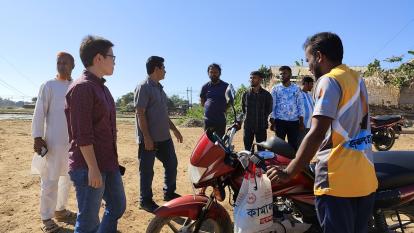The country can become a tourist hotspot if it adopts the right path to make effective plans for tourism development. Bangladesh can be a winning destination where local communities truly benefit from tourism by practicing the concept of community-based tourism (CBT).
Community-Based Tourism: Connecting Thailand’s Experiences and Reframing Sustainable Tourism in Bangladesh
December 31, 2022
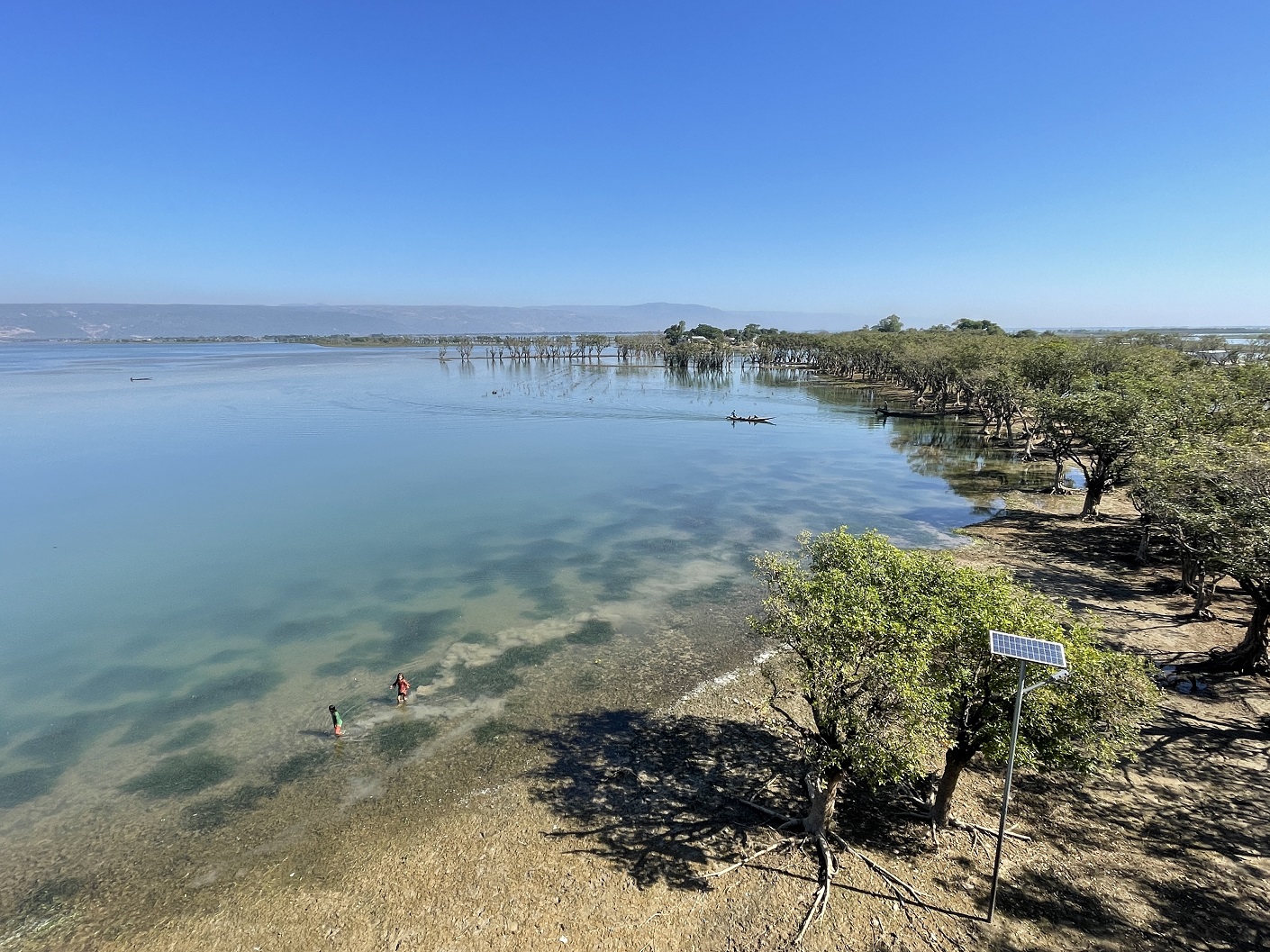
Natural view of the Tanguar Haor from the watchtower
By Ramiz Uddin, Head of Experimentation, UNDP Accelerator Lab, Bangladesh
Pattamon Rungchavalnont, Head of Solutions Mapping, UNDP Accelerator Lab, Thailand
Samiha Sima, Experimentation and Innovation Associate, UNDP Accelerator Lab, Bangladesh
Bangladesh, a darling child of nature, has the potential to become an attractive tourist destination given its beautiful landscape and glorious history. The country is home to the world’s longest beach in Cox’s Bazar and the world’s largest mangrove forest in Sundarban. Despite its potential, Bangladesh recorded only 323,000 tourists in 2019, and the contribution of tourism to the country’s GDP was only 4.4 % and has not jumped to its expected growth.[1] During the COVID-19 pandemic, this industry faced a considerable wreck causing a substantial decline of 21.9% in sectoral employment.[2] However, it is predicted that, in the post-pandemic era, tourism will be a key tool in combating and repairing the damage caused by Covid-19. It is also estimated that by 2030, more than 2 million workforces will be added to the sector creating a large number of informal employment.
The country can become a tourist hotspot if it adopts the right path to make effective plans for tourism development. Bangladesh can be a winning destination where local communities truly benefit from tourism by practicing the concept of community-based tourism (CBT). As a form of tourism, CBT refers more specifically to tourism management that involves local communities directly, placing key decisions in their own hands and ensuring the distribution of benefits among local communities. This kind of tourism empowers host communities and provides space for sharing experiences and fostering cultural exchanges. Bangladesh cannot miss the opportunity to learn from the good practices of CBT around the world to make sustainable growth in this sector. Therefore, this blog will discuss key learnings from Thailand CBT as well as existing models in Bangladesh, and explore further development of CBT in the country.
Connecting and Learning from Thailand’s CBT experiences
There are many countries in the world like Thailand, Indonesia, Philippines, Nepal, Vietnam, Malaysia, and Lao PDR, where CBT is systematically and successfully managed. It must be noted that while the concept of CBT places local communities at the centre of tourism development process, multisectoral collaboration is required to foster a flourishing CBT ecosystem. Some communities may have the capacity to develop CBT entirely on their own, but many can find it challenging. Community empowerment agenda can greatly benefit from multi sectoral stakeholder support. Drawing from Thailand’s CBT experience, the government of Thailand created the Designated Areas for Sustainable Tourism Administration (DASTA) to take lead on the development of CBT, supporting local communities through their CBT journey- from mapping their tourism potentials to building their capacities, co-creating tourism products, ensuring quality products and services, promoting and marketing CBT, etc. Although DASTA has been instrumental, they are not the only key driver; Thailand is fortunate to have a few social enterprises (SE) working to develop CBT as well. One notable example is Local Alike which has been actively building local capacities and connecting them to the market. As the local alike team works closely with local communities, they are able to co-curate unique tourism experiences which allow tourists to enjoy the charm of local culture and traditions. Local Alike has also engaged with the large-scale private sector to explore innovative financing possibilities.
The UNDP Accelerator Lab Thailand has been working with the above-mentioned partners to contribute innovative approaches and strengthen CBT through the lens of sustainability. Apart from generating economic benefits for local communities, how do we incentivize environmental conservation through the tourism process? To mention a few good examples from Thailand, Chulabhorn Pattana 9 community in the south has recently promoted bird watching as a biodiversity-based tourism activity, redesigned their services to reduce single-use plastics, and introduced a waste management system. Meanwhile, Nongsan community in the northeast is seeking to tap into circularity innovation, turning textile waste from their famous natural dye handicraft production into new raw materials for special ‘circular design’ collection. CBT brings out an endless array of local creativity but to materialize them, support from multi-sectoral stakeholders are critical. With a conducive environment from stakeholder’s support, local communities can be empowered and drive sustainable development agenda through tourism.
Manipuri Community-Based Tourism: Hidden Gems of the Eastern Bangladesh
Considering the case of CBT in Bangladesh, a ray of hope shines through as CBT has already been in practice in some parts of the country on a small scale. Moreover, since 2016, the Bangladesh Tourism Board has also started to support CBT development in a few areas and now plans to expand to more. To understand CBT in Bangladesh, let’s have a look at an example of a success story from the Manipuri CBT.
Located in the eastern region of Bangladesh, Manipuri community in Kamalganj sub-district of Sylhet division has been officially operating community-based tourism since 2018. While Sylhet is already well-known for its beautiful tea gardens and indigenous communities, Manipuri CBT offers tourists the opportunity to experience authentic local culture at their very well-managed homestay, enjoying local cuisine, organic agriculture, traditional music, rituals, handmade crafts and textiles, etc. The CBT is also committed to protecting and preserving the environment and local biodiversity, including endangered bird species.
[1] https://www.worlddata.info/asia/bangladesh/tourism.php
[2] https://www.tbsnews.net/economy/bangladeshs-tourism-lost-tk26490cr-2020-wttc-259888
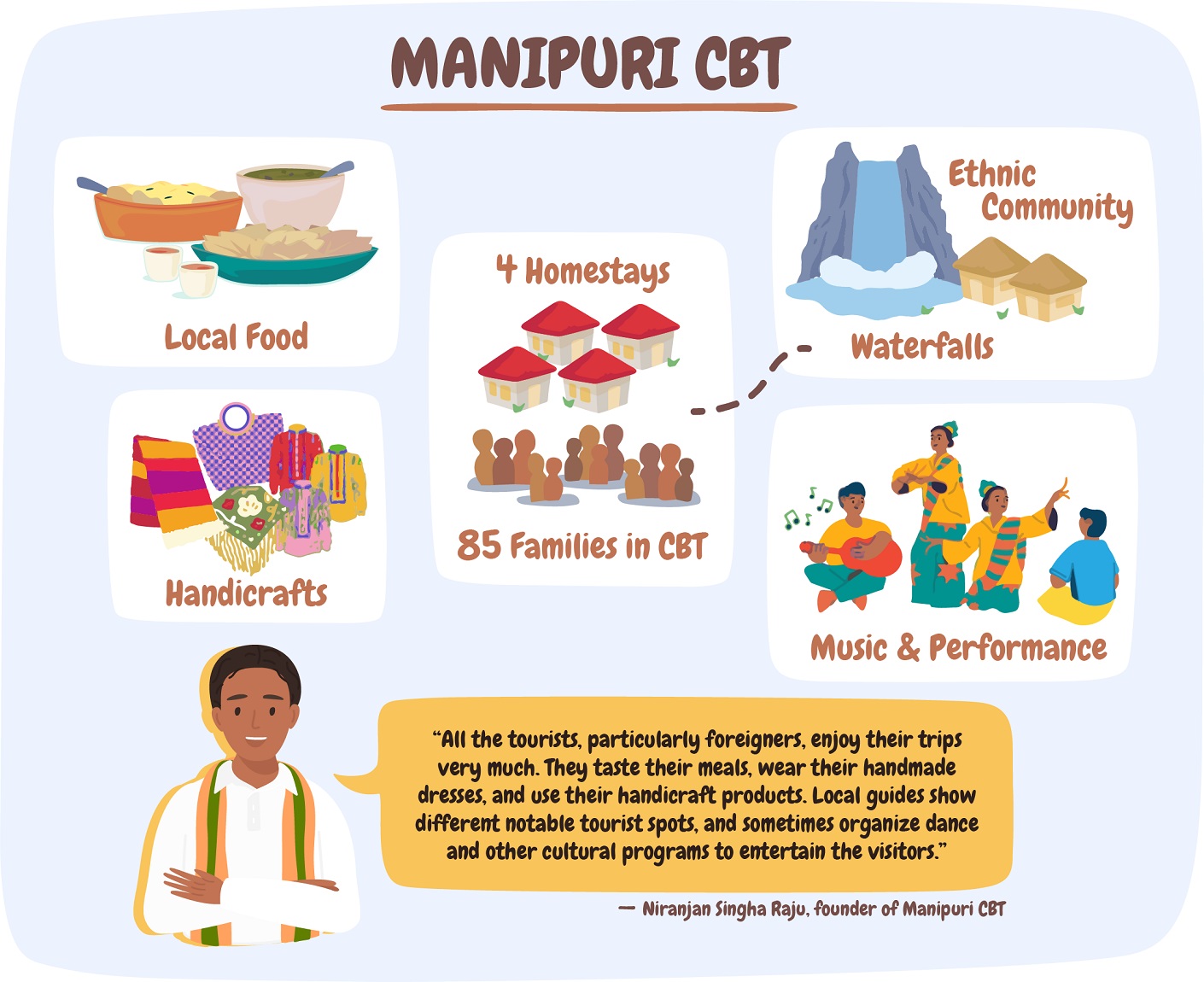
CBT practice in Manipuri Para, kamalganj (Sylhet Division)
Tea garden visit, local handicrafts and local foods offered by Manipuri CBT
How did Manipuri CBT begin? Six years back, the concept of CBT was introduced in this community by Niranjan Singha Raju, a local entrepreneur who is now also the president of the Community-Based Tourism Association of Manipuripara. He started CBT by turning his own home into a homestay, and gradually inspires others to welcome tourists to their homes, showcase their cultural products and handicrafts, and offer local cuisine in order to preserve their cultural heritage as well as generate additional income. Although only 4 households have sufficient capacity to host guests at their homestay, Niranjan ensures that more locals are benefiting from CBT by rotating families to provide various CBT-related services e.g. one family supplying ingredients for the meals while another doing the cooking, then two more families taking turn to support these tasks the next day. Niranjan’s environmental awareness is also notable; eco-friendly garbage bins are installed around the compound, keeping the area outstandingly clean and pleasant. As Manipuri CBT began to gain traction, external support was offered to further uplift the community’s CBT operations. Stressing the need for community tourism, Bangladesh Tourism Board has made efforts to ensure intensive development, engaging the stakeholders in the system and creating business opportunities for the locals. They also offered capacity-building activities for the locals to develop tourism products such as souvenirs and boutiques, traditional outfits etc. Discussing with entrepreneurs and inbound tour operators, they helped the locals to find out the products the foreigners like most.
Although Niranjan’s successful CBT initiative is an inspiring story, many more families and communities can have a higher chance of success doing CBT if they are provided with adequate support from the government and other stakeholders. Many may be wishing to start their CBT but are unable to due to a lack of capital. As an apex organization established by the government, the Palli Karma-Sahayak Foundation (PKSF) has been promoting CBT by providing loan facilities for investors but that is not enough. Mechanisms must be developed to ensure actual benefits for the local communities. Especially with the growing market for CBT as tourists seek for authentic experiences, a large-scale strategic development plan for CBT by the government and multisectoral stakeholder collaboration are required to promote and expand the benefits of CBT.
Possibility of CBT replication in the climate-vulnerable Tanguar Haor
Tanguar Haor is one of the most beautiful and largest freshwater wetlands, full of amazing natural resources, in the northeastern district of Sunamganj. Extending up to the border of India, the area comprises of many attractive tourism spots- from Jadukata River, a blue water canal surrounded by mountains of Meghalaya, to Niladri Lake, the shelter of an abandoned limestone mine or the Shimul Garden, a garden of reddish aura of shimul petals. Apart from providing the local population with livelihoods based on wetland ecosystem, the area is also home to diverse flora and fauna, including migratory birds and freshwater evergreen swamp forest. Unsurprisingly, UNESCO declared this area the country’s second wetland of international importance. However, the natural resources have been degrading over the years, so the government of Bangladesh has classified this site as an ‘Ecologically Critical Area (ECA)
Breathtaking beauty of the Tanguar Haor in Sunamganj
Tanguar Haor tourism is currently a case of seasonal tourism. The majority of the local people depend on income during the four-month tourist season in monsoon. The high levels of water create picturesque scenery that attracts many tourists, resulting in numerous boat tours and related services that provide a staple income for the locals. In peak season, more than 160 small transport boats and large houseboats for tourists can be found roaming around daily. During the off-season, the locals turn to farming, fishing, and duck rearing for moderate incomes.
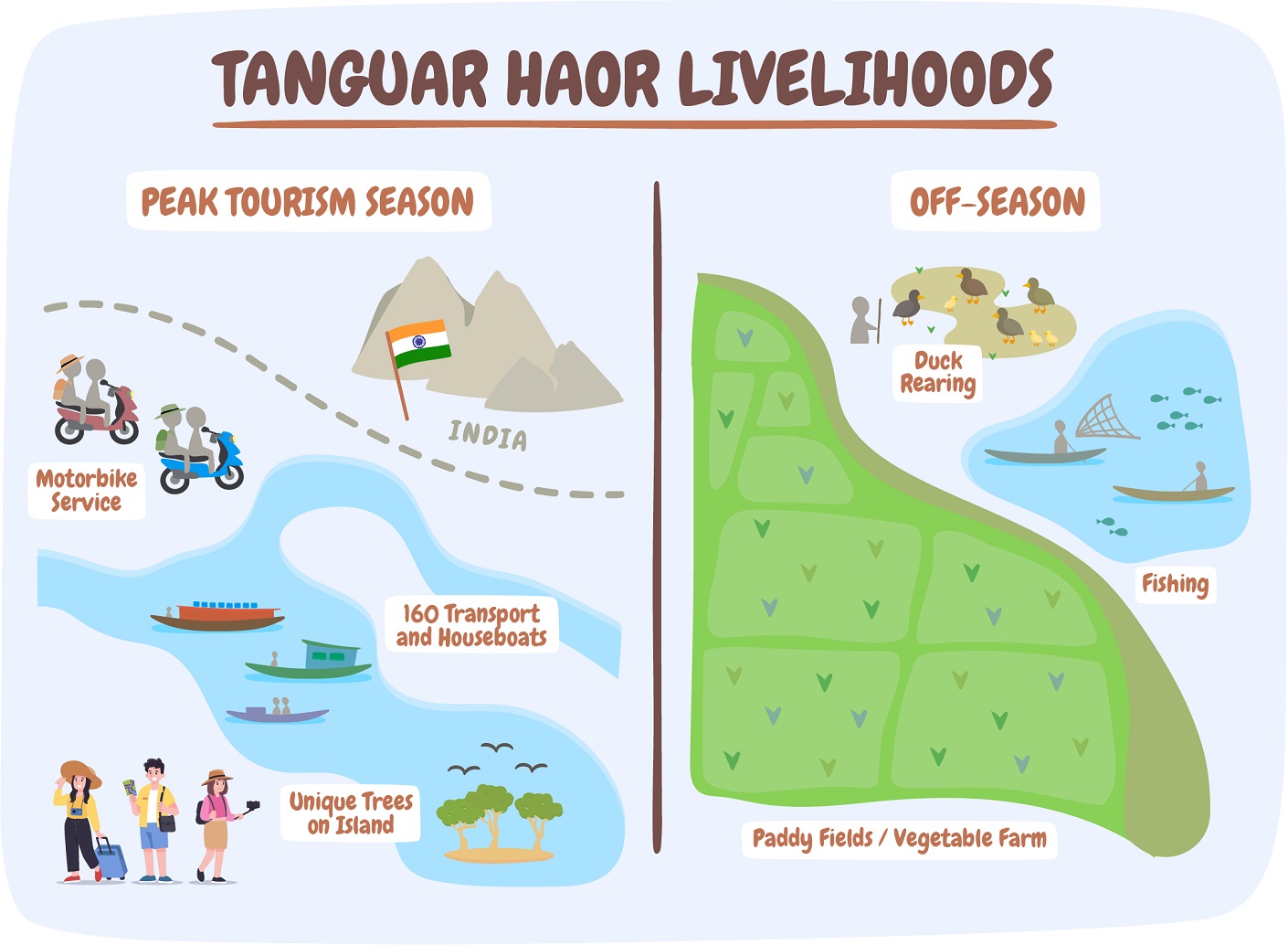
Livelihood opportunities in Tanguar Haor (both peak season and off season)
A conversation with the Boatowners Association of Tanguar Haor revealed an emerging problem. As tourism blossoms there, external operators and investors (mostly from Dhaka city) start to dominate the market. These outsiders have the competitive advantage of connecting with the market nationwide while local boatmen and businesses are only waiting for tourists to arrive and find them in the local area. Local services such as boat tours, motorbike tours, and restaurants are also operating separately without a single point of coordination. While boatmen highlighted their lack of social media skills as the main problem in reaching the market, some local restaurants already develop very well-presented social media pages, but they are all operating independently.
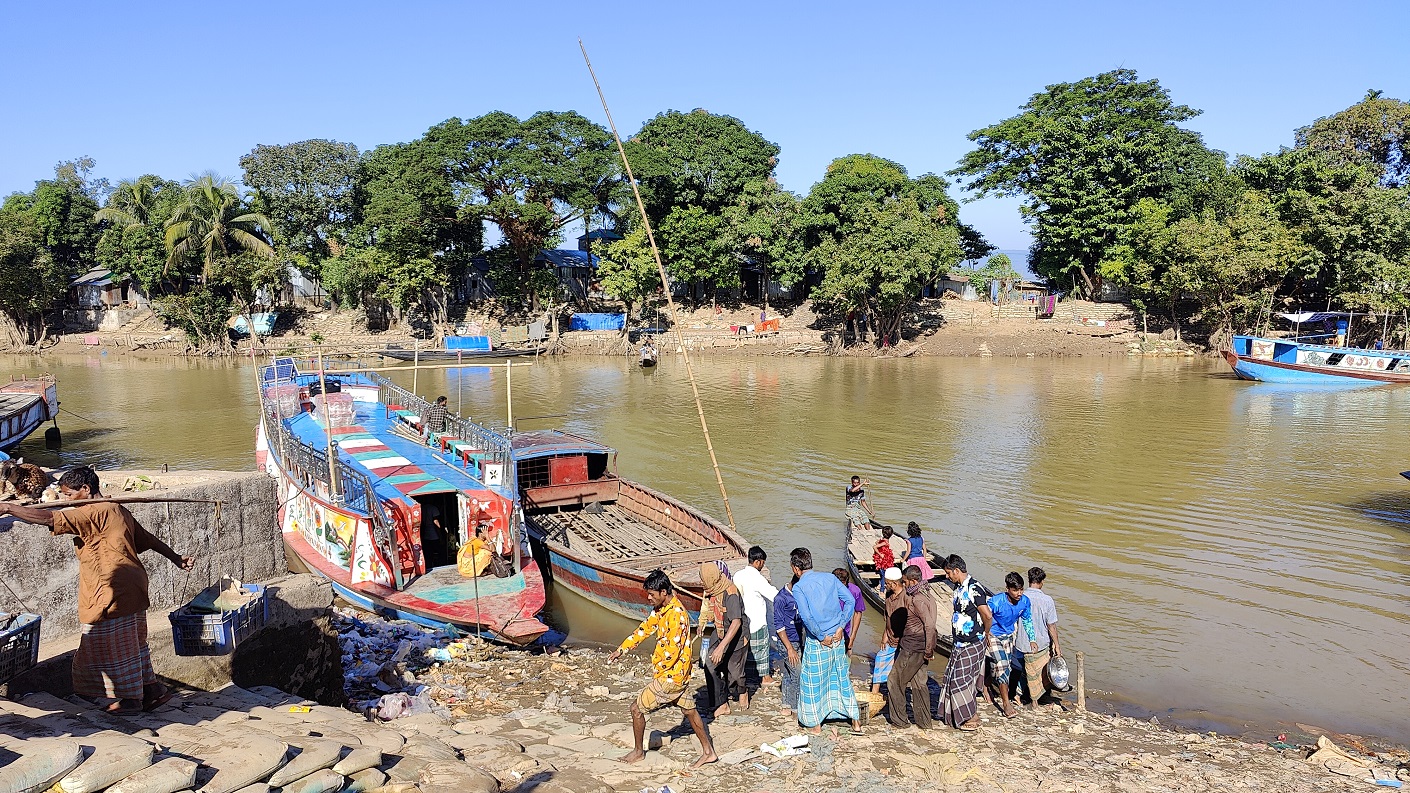
Houseboat and passenger boats are the main mode of transportation in these waterways
Local boat drivers and motorbike drivers are discussing the issues of their livelihood.
Increased internal and inter-community cooperation to build integrated networks of CBT can be a starting point for improving local competitive advantage and local livelihoods. Applying sustainable eco-friendly CBT can also gear up a symbiotic relationship between nature and the communities in Tanguar Haor. As an environmentally critical area, CBT can incentivize local people to conserve their invaluable natural resources. All in all, community-based eco-tourism could be a possible solution for the local communities to ensure long-term local economic development as well as sustainable management of the natural resources of Tanguar Haor.
In discussion with the local motorbike drivers on tourism development in Tahirpur
Way Forward for CBT in Tanguar Haor
Considering what we learnt about the local context and combining experience from Thailand’s CBT, recommendations are developed to foster local economic development and promote cultural and environmental conservation through CBT development in Tanguar Haor.
- Connect existing local operators and service providers related to tourism to form a local tourism association which can provide one-stop service to visitors
- Facilitate learning exchange between local representatives and model CBT in the region e.g. Manipuri CBT to provide inspiration and good examples of CBT management
- Work with local community and possibly researchers to map cultural capitals and co-create unique tourism offers which tourists can only experience through CBT (not with external tour operators)
- Explore new tourism offers (including attractions, activities, food, etc.) that can be offered all year round and will expand benefits to more people in the local community, especially vulnerable groups such as women
- Provide capacity building and training for local operators and service providers, especially concerning hygiene, and product and service standards
- Develop appropriate accommodation facilities in close collaboration with local authorities to ensure safety in the context of the border area
- Set up and promote the social media platform of the local tourism association to become reachable for domestic and international tourists
Establish a tourist data collection mechanism to gain insights on tourist’s demographics, preferences, experience, and feedback - paving way for further development of the CBT masterplan and multi-sectoral stakeholder engagement strategy for the area

 Locations
Locations







